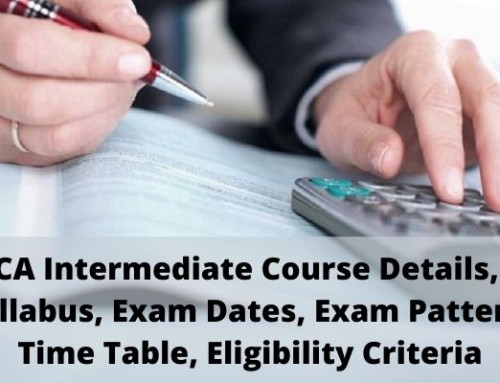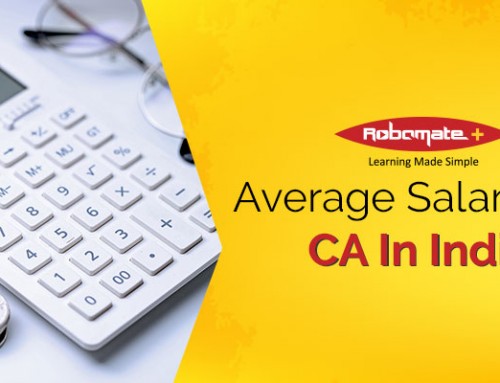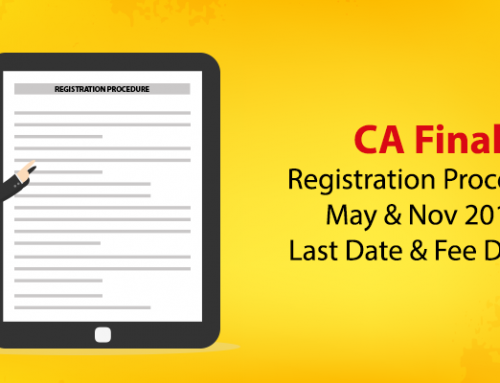CPT Syllabus For June 2017
There are 4 subjects in CPT Syllabus i;e Fundamentals of Accounting, Mercantile Law, General Economics and Quantitative Aptitude. There are 2 sessions in CA CPT exam i;e Session I and Session II. In session I, Fundamentals of accounting and Mercantile Law for 100 marks and in session II, General Economics and Quantitative Aptitude (Maths) For 100 Marks.
| Common Proficiency Test | ||
| Session I | ||
| Section A | Fundamentals of Accounting | 60 Marks |
| Section B | Mercantile Law | 40 Marks |
| Session II | ||
| Section C | General Economics | 50 Marks |
| Section D | Quantitative Aptitude | 50 Marks |
We are providing CA CPT Syllabus in PDF format. Click below links to download CPT Syllabus of Fundamentals of Accounting, Mercantile Law, General Economics and Quantitative Aptitude for June 2017.
A candidate is required to secure a minimum of 30 per cent marks in each Section and a minimum of 50 per cent marks in aggregate in all the four Sections to pass the Common Proficiency Test.Minimum Passing Marks For CPT
In other words, it is clarified that if a candidate secures a minimum of 50 per cent marks in the aggregate but fails to secure the minimum marks required in any one or more of the sections A, B, C or D (as mentioned above), his result will be FAIL. Similarly, if a candidate secures a minimum of 30 percent marks in each section but fails to secure 50 per cent marks in the aggregate of all sections,his result will be FAIL.
| Minimum Passing Marks for CPT | |||
| Section | Subject | Maximum Marks | Minimum Marks |
| A | Fundamentals of Accounting | 60 | 18 |
| B | Mercantile Law | 40 | 12 |
| C | General Economics | 50 | 15 |
| D | Quantitative Aptitude | 50 | 15 |
| Total | 200 | 100* | |
Common Proficiency Test Syllabus
(One paper – Four hours – 200 Marks)
Level of Knowledge: Basic knowledge
SESSION – I
(Two Sections– Two hours – 100 Marks)
CPT Fundamentals of Accounting Syllabus For June 2017
Section A: Fundamentals of Accounting ( 60 Marks )
1. Theoretical Framework
(i) Meaning and Scope of accounting
(ii) Accounting Concepts, Principles and Conventions
(iii) Accounting Standards – concepts, objectives, benefits
(iv) Accounting Policies
(v) Accounting as a measurement discipline – valuation principles, accounting estimates
2. Accounting Process
Books of Accounts leading to the preparation of Trial Balance, Capital and revenue expenditures, Capital and revenue receipts, Contingent assets and contingent liabilities, Fundamental errors including rectifications thereof.
3. Bank Reconciliation Statement
4. Inventories
Basis of inventory valuation and record keeping.
5. Depreciation accounting
Methods, computation and accounting treatment of depreciation, Change in depreciation
methods.
6. Preparation of Final Accounts for Sole Proprietors
7. Accounting for Special Transactions
(a) Consignments
(b) Joint Ventures
(c) Bills of exchange and promissory notes
(d) Sale of goods on approval or return basis.
8. Partnership Accounts
Final accounts of partnership firms – Basic concepts of admission, retirement and death of a partner including treatment of goodwill.
9. Introduction to Company Accounts
Issue of shares and debentures, forfeiture of shares, re-issue of forfeited shares, redemption of preference shares.
CPT Mercantile Law Syllabus For June 2017
Section B: Mercantile Laws ( 40 Marks )
1. The Indian Contract Act , 1872: An overview of Sections 1 to 75 covering the general nature of contract , consideration , other essential elements of a valid contract , performance of contract and breach of contract.
2. The Sale of Goods Act, 1930: Formation of the contract of sale – Conditions and Warranties – Transfer of ownership and delivery of goods – Unpaid seller and his rights.
3. The India Partnership Act, 1932: General Nature of Partnership – Rights and duties of partners –Registration and dissolution of a firm.
SESSION – II
(Two Sections– Two hours – 100 Marks)
CPT General Economics Syllabus For June 2017
Section C: General Economics ( 50 Marks )
(I) Micro Economics
1. Introduction to Micro Economics
(a) Definition, scope and nature of Economics
(b) Methods of economic study
(c) Central problems of an economy and Production possibilities curve.
2. Theory of Demand and Supply
(a) Meaning and determinants of demand, Law of demand and Elasticity of demand ─ Price, income and cross elasticity
(b) Theory of consumer ’s behavior – Marshall Ian approach and Indifference curve approach
(c) Meaning and determinants of supply, Law of supply and Elasticity of supply.
3. Theory of Production and Cost
(a) Meaning and Factors of production
(b) Laws of Production – The Law of variable proportions and Laws of returns to scale
(c) Concepts of Costs ─ Short-run and long-run costs, Average and marginal costs, Total, fixed and variable costs.
4. Price Determination in Different Markets
(a) Various forms of markets – Perfect Competition, Monopoly, Monopolistic Competition and Oligopoly
(b) Price determination in these markets.
(II) Indian Economic Development
5. Indian Economy – A Profile
(a) Nature of the Indian Economy
(b) Role of different sectors – Agriculture, Industry and Services in the development of the Indian economy, their problems and growth
(c) National Income of India – Concepts of national income, Different methods of measuring national income, Growth of national income and per capita income in various plans.
(d) Basic understanding of tax system of India – Direct and Indirect Taxation
6. Select Aspects of Indian Economy
(a) Population – Its size, rate of growth and its implication for growth
(b) Poverty – Absolute and relative poverty and main programs for poverty alleviation
(c) Unemployment – Types, causes and incidence of unemployment
(d) Infrastructure ─ Energy, Transportation, Communication, Health and Education
(e) Inflation
(f) Budget and Fiscal deficits
(g) Balance of payments
(h) External debts.
7. Economic Reforms in India
(a) Features of economic reforms since 1991
(b) Liberalisation, Privatisation and Disinvestment
(c) Globalisation.
8. Money and Banking
(a) Money – Meaning and functions
(b) Commercial Banks – Role and functions
(c) Reserve Bank of India – Role and functions, Monetary policy.
CPT Quantitative Aptitude Syllabus For June 2017
Section D: Quantitative Aptitude ( 50 Marks )
1. Ratio and proportion, Indices, Logarithms
2. Equations
Linear – simultaneous linear equations up to three variables, quadratic and cubic equations in one variable, equations of a straight line, intersection of straight lines, graphical solution to linear equations.
3. Inequalities
Graphs of inequalities in two variables ─ common region.
4. Simple and Compound Interest including annuity ─ Applications
5. Basic concepts of Permutations and Combinations
6. Sequence and Series – Arithmetic and geometric progressions
7. Sets, Functions and Relations
8. Limits and Continuity ─ Intuitive Approach
9. Basic concepts of Differential and Integral Calculus (excluding trigonometric functions)
10. Statistical description of data
(a) Textual, Tabular & Diagrammatic representation of data.
(b) Frequency Distribution.
(c) Graphical representation of frequency distribution – Histogram, Frequency Polygon, Ogive
11. Measures of Central Tendency and Dispersion
Arithmetic Mean, Median – Partition Values, Mode, Geometric Mean and Harmonic, Mean, Standard
deviation, Quartile deviation
12. Correlation and Regression
13. Probability and Expected Value by Mathematical Expectation
14. Theoretical Distributions
Binomial, Poisson and Normal.
15. Sampling Theory
Basic Principles of sampling theory , Comparison between sample survey and complete enumeration ,
Errors in sample survey , Some important terms associated with sampling , Types of sampling , Theory of estimation , Determination of sample size .
16. Index Numbers
CPT New Syllabus For June 2017
Changes in CPT Syllabus From 2017:
1. The present entrance exam CPT (Common Proficiency Test) has changed to “Foundation Exam”
2. CPT MCQ (Multiple Choice Questions) based exam has changed to Foundation descriptive exam. Now you can register for CPT before 6 months. In new scheme you should register before 9 months.
3. Adequate time gap is given so that students get sufficient time to study since the Foundation Course has been made descriptive. Also, there is an addition of full paper.
4. Foundation Examination will be partly descriptive in nature.
5. ICAI has added two additional papers in Foundation exam (CPT). They are 1. General English for 40 Marks. 2. Business and Commercial Knowledge (40 Marks).
CA Syllabus 2016 – Foundation Course (CPT) syllabus applicable from 2017
Foundation Course: Number of Papers — 4
There are 4 papers in CA Foundation course. Remember one thing that Paper 2 and Paper 4 will be Objective type papers. Read below !!
Paper I: Principles and Practices of Accounting (100 Marks)
Paper 2*: Business Mathematics and Logical Reasoning & Statistics (100 Marks)
- Part I: Business Mathematics and Logical Reasoning (60 Marks)
- Part II: Statistics (40 Marks)
Paper 3: Mercantile Law & General English (100 Marks)
- Part I: Mercantile Law (60 Marks)
- Part II: General English (40 Marks)
Paper 4*: Business Economics & Business and Commercial Knowledge (100 Marks)
- Part I: Business Economics (60 Marks)
- Part II: Business and Commercial Knowledge (40 Marks)
*Paper 2 and Paper 4 will be Objective type papers
Note :
1. Passing percentage:Aggregate- 50% and Subject-wise- 40% at one sitting.
2. Objective type question of I or more marks.
3. Examination: In the month of November and May after passing Class XII
Note : Material & Content Credits: www.icai.org










